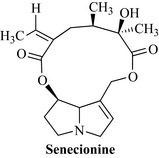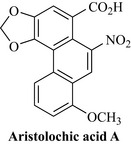Chapter 10 Toxicity of herbal constituents
This chapter is not about toxic plants as such (see Nelson et al 2006), but about those plants used as herbal medicines and in therapy. Most common herbal remedies are fairly safe in clinical use; not because they are ‘natural’, but because the long history of use has uncovered some of the adverse effects.
Pyrrolizidine alkaloids
These have only been reported in the plant families Boraginaceae, Asteraceae, Leguminosae, Apocynaceae, Ranunculaceae and Scrophulariaceae, and not in all species. Medicinal herbs that may be affected include comfrey (Symphytum spp.), butterbur (Petasites hybridus (L.) P. Gaertn., B. Mey. & Scherb.), alkanet (Alkanna tinctoria Tausch, Boraginaceae), coltsfoot (Tussilago farfara) and hemp agrimony (Eupatorium cannabinum L., Asteraceae). Not all pyrrolizidine alkaloids are toxic, only those that are unsaturated at the 1,2-position (e.g. senecionine; Fig. 10.1). These are liver toxins and can produce veno-occlusive disease of the hepatic vein as well as being hepatocarcinogenic, and their effects are cumulative. Several documented clinical examples can be found in the literature. Although highly toxic, they are chemically rather labile and may, therefore, not present the serious risk originally thought, at least in herbal medicines that have undergone a lengthy process involving heat. For example, when six commercial samples of comfrey leaf were tested, none of these alkaloids were detectable. However, in fresh plant material, and also root samples, they may be present in significant amounts. The total recommended maximum dose of these alkaloids is less than 1 μg daily for less than 6 weeks per year. If herbal products, which may contain these, are to be employed (and some are very useful, e.g. butterbur and coltsfoot; see Chapter 16), the content must be estimated and, if necessary, the alkaloids should be removed before use.
Aristolochic acid
Most species of birthwort (Aristolochia, known as snakeroot) and related genera including Asarum, all from the family Aristolochiaceae, contain aristolochic acid and aristolactams. Aristolochia has been found as an ingredient in a slimming formula along with dexfenfluramine and in Europe, since the mid 1990s, more than one hundred cases of nephropathy caused by the systemic and long term use of Chinese snakeroot (Aristolochia fangchi Y.C. Wu ex L.D. Chow & S.M. Hwang), mainly in these weight-loss preparations, has highlighted the risk of using preparations which contain aristolochic acids. Aristolochic acid A (Fig. 10.2) is nephrotoxic and has been responsible for several deaths from renal failure. Aristolochia and other species containing these compounds are banned from sale in Europe and the USA, but may still be present in imported Chinese medicines, and A. fangchi has been found substituted for Stephania tetrandra S. Moore. Herbs containing these substances must not be used. The disastrous consequences of using them have been a wake-up call for the regulatory authorities and the herbal industry. On the other hand, in many regions of the world species from the genus are widely used as local and traditional medicines especially in the treatment of gastrointestinal complaints like diarrhoea, of snake bites and poisoning, and of gynaecological conditions, including the treatment of sexually transmitted diseases (STDs) such as syphilis and gonorrhoea (Heinrich et al 2009; Nortier et al 2000).
Stay updated, free articles. Join our Telegram channel

Full access? Get Clinical Tree




